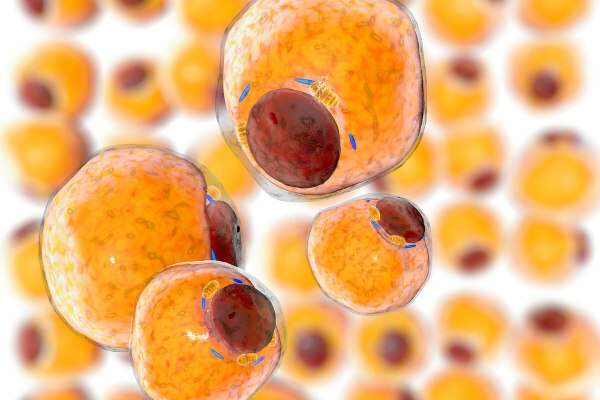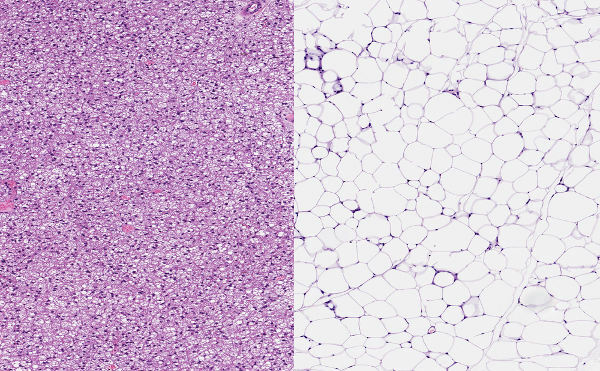adipose tissue is a special kind of connective tissue which is characterized by storing fat in cells specialized, called adipocytes. It is of great importance, since its layer is responsible, among other functions, for ensuring thermal insulation and being an important source of energy. Next, we will expand our knowledge about adipose tissue, learning a little more about its characteristics and functions.
Read too:Human body - levels of organization, organs and main systems
Fatty tissue characteristics
It is a special kind of connective tissue which stands out for storing a large amount of fat. This is present in the so-called adipose cells or adipocytes, which form large aggregates that make up this tissue. It is noteworthy, however, that these cells can also be found in isolation or forming small clusters in loose connective tissue.
Adipocytes are cells that, like others eukaryotic cells, present plasma membrane, nucleus and membranous organelles. The most striking feature in them is the
presence of fat in the cytoplasm which often occupies practically the entire region, moving the nucleus to a more peripheral location in the cell. They are the only ones able to store lipids in the form of triglycerides, without any of its functions being impaired.
The formation of adipose tissue occurs based on mesenchymal cells (embryonic tissue) undifferentiated. As we know, adipocytes are capable of store fat in your cytoplasm, being observed in the beginning of its formation the accumulation of this substance in small droplets. These can merge to form a single large drop or remain separate.
Types of adipose tissue
The adipose tissue of mammals can be classified into two types: common or yellow or unilocular adipose tissue and brown or multilocular adipose tissue. See more about them below:
Common or yellow or unilocular tissue
It has large cells that, when developed, present just a big drop of fat, which occupies a large part of the cell. The adipocytes of this type of adipose tissue can increase in size as they accumulate fat inside them. This fat has dissolved carotenes, and, therefore, this tissue has a color that varies from white to dark yellow, and these variations are related to the diet.
This tissue is highly vascularized and has connective tissue septa that have vessels and nerves. Collagen fibers leave these septa and ensure the support of adipocytes. The nerve endings in this tissue are found in the walls of the blood vessels presenting only a few innervated adipocytes.
Read too:Major endocrine glands and their hormones.
The unilocular adipose tissue forms the so-called adipose panicle, which is a layer of fabric located under the skin. When we are born, this layer is about the same thickness all over the body, however, as we grow, it develops in some areas and shrinks in others.
This type of adipose tissue has a series of functions, being related to energy reserve, protection and support of our internal organs, and acting as a thermal insulator.

Brown or multilocular adipose tissue
It has cells that, when developed, have fat droplets of different sizes in the cytoplasm, as well as several mitochondria. Due to the great vascularization and the large amount of mitochondria, this tissue acquires a brown color. While in unilocular adipose tissue we have large cells, in multilocular adipose tissue these are small and polygonal in shape.
Multilocular adipose tissue is specialized in the production of heat, being related, therefore, to the maintenance of body temperature. This tissue in adults is present in only a few regions, unlike the unilocular type, which is found virtually throughout the body. A greater amount of unilocular adipose tissue is seen in the newborn. In animals that perform hibernation, it is present in large quantities; in them, it is known as hibernating gland.
Know more: What is ectothermy and endothermy?
Adipose tissue functions
Fat tissue stores lipids, therefore being a great energy store, in addition, guarantees protection against mechanical shock and acts in thermal insulation, avoiding excessive heat loss or excessive temperature rise.
This tissue can also be found filling some parts of our body, thus ensuring that the organs remain in proper position.
Also, adipose tissue has the ability secretary, being responsible, for example, for the release of the hormone leptin. This hormone acts by informing the brain about the presence of excessive adipose tissue, leading to appetite suppression.
By M. Vanessa Sardinha dos Santos
Biology teacher
Source: Brazil School - https://brasilescola.uol.com.br/biologia/tecido-adiposo.htm
